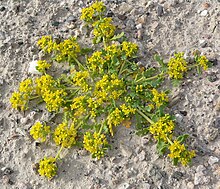| Lepidium | |
|---|---|

| |
| Lepidium flavum | |
| Scientific classification | |
| Kingdom: | Plantae |
| Clade: | Tracheophytes |
| Clade: | Angiosperms |
| Clade: | Eudicots |
| Clade: | Rosids |
| Order: | Brassicales |
| Family: | Brassicaceae |
| Genus: | Lepidium L. (1753) |
| Species[1] | |
|
265, see text | |
| Synonyms[1] | |
|
Synonymy
| |
Lepidium is a genus of plants in the mustard/cabbage family, Brassicaceae. The genus is widely distributed in the Americas, Africa, Asia, Europe, and Australia.[2] It includes familiar species such as garden cress, maca, and dittander. General common names include peppercress, peppergrass, pepperweed, and pepperwort. Some species form tumbleweeds.[3] The genus name Lepidium is a Greek word meaning 'small scale', which is thought to be derived from a folk medicine usage of the plant to treat leprosy, which cause small scales on the skin. Another meaning is related to the small scale-like fruit.[4]
- ^ a b Lepidium L. Plants of the World Online. Retrieved 3 April 2024.
- ^ Lepidium. Flora of North America.
- ^ Faulkner, H. W. (1917). The Mysteries of the Flowers. Frederick A. Stokes company. p. 238. page 210
- ^ Sia Morhardt and Emil Morhardt California Desert Flowers: An Introduction to Families, Genera, and Species , p. 101, at Google Books